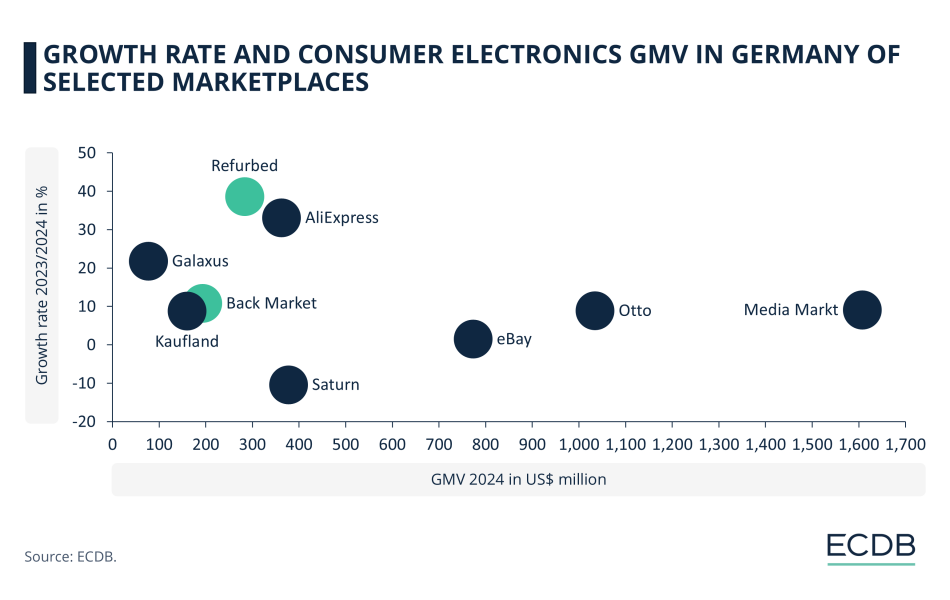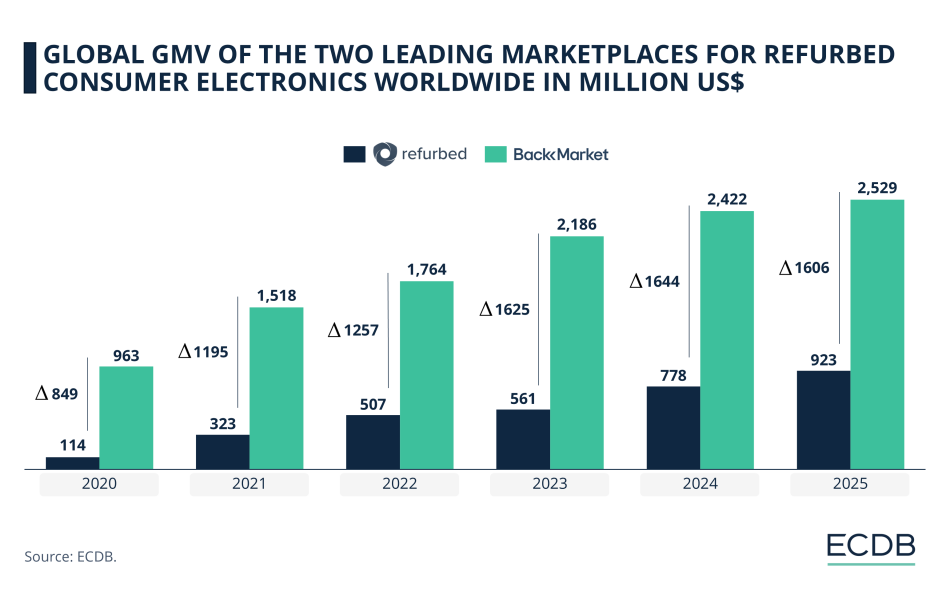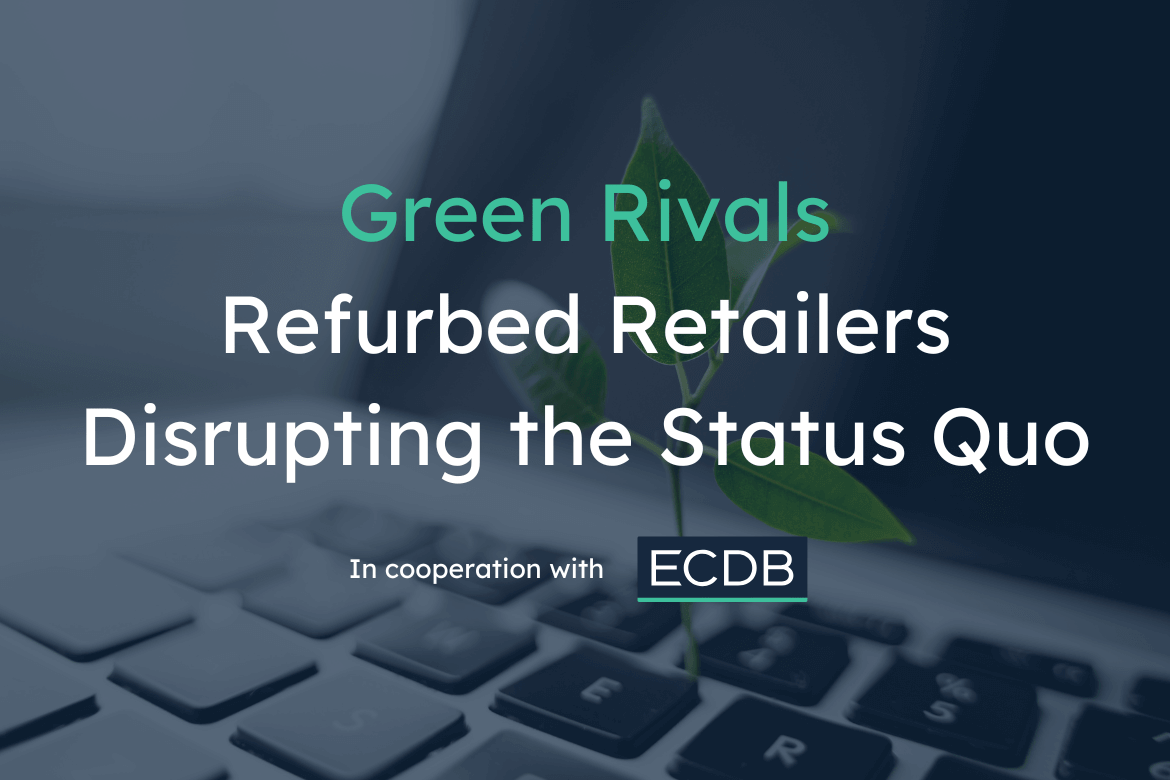Commercial collaboration
By Nadine Koutsou-Wehling, Data Journalist at ECDB
Sustainable shopping is no longer a side trend. In Germany and beyond, refurbished consumer electronics are reshaping the competitive landscape of eCommerce. Platforms like Refurbed and Back Market are climbing national rankings, gaining ground on legacy retailers, and redefining what value means in digital retail.
Based on ECDB data, this article explores how the two leading refurbishment platforms compare in Germany and on a global scale – and what their growth reveals about the future of consumer electronics online.
Germany’s consumer electronics market: Refurbed takes the lead
Germany’s consumer electronics landscape is shifting. For years, the market was dominated by large multichannel retailers like Media Markt (GMV 2024: €1.6B) and Otto (€1.03B). But now, new players are gaining speed – and credibility.
Refurbed, a platform specializing in refurbished consumer electronics, reached €283.4M in GMV in 2024, growing an impressive +38.6% year-over-year. That makes it the fastest-growing platform among the top players in Germany – and enough to climb to rank 8 in the consumer electronics eCommerce ranking. Back Market, its closest rival in the same segment, follows just behind at rank 9, with a GMV of €193.1M and a solid +10.8% growth rate.
Legacy retailers are feeling the pressure. Saturn, once a strong contender, saw its GMV shrink to €377.3M – a -10.4% decline. Meanwhile, players like AliExpress (+33.1%), Galaxus (+21.8%), and Kaufland (+8.8%) show that growth is increasingly found outside the traditional retail mold.

Refurbed’s rise signals more than a temporary shift. Refurbished consumer electronics are no longer just an affordable alternative – they are a competitive force.
Global champions in refurbishment: Back Market leads, Refurbed gains
Zooming out from Germany, the dynamic between Refurbed and Back Market shifts. On a global level, Back Market remains the clear leader in refurbished consumer electronics – and by a significant margin. In 2024, Back Market recorded a global GMV of US$2.42 billion, while Refurbed generated US$778 million, resulting in an absolute gap of US$1.64 billion.

This gap has widened steadily over the past few years. In 2020, it stood at US$849 million, and by 2023 it had nearly doubled to US$1.63 billion. Although the distance between the two continues to be substantial, 2025 may mark a subtle shift in momentum. According to ECDB forecasts, Refurbed is expected to grow by +18.7% in 2025, reaching US$923 million, while Back Market’s growth is projected to slow to +4.4%, pushing its GMV to US$2.53 billion. This would slightly narrow the gap for the first time in years – from US$1.64 billion to US$1.61 billion.
Back Market clearly maintains the upper hand in terms of global scale, but Refurbed is steadily gaining ground, suggesting a long-term convergence in the making.
Platform vs Platform: Speed or scale?
Refurbed and Back Market follow similar business models. Both acquire used consumer electronics, refurbish them to high quality standards, and sell them through their own marketplace platforms. Both focus on price-conscious and sustainability-minded consumers.
But their market strategies differ:
- Back Market has built international scale early, dominating core European markets and the US.
- Refurbed is catching up with higher growth rates and a strong position in German-speaking markets, where it now ranks ahead of Back Market.
The race is increasingly a battle between speed and scale. Back Market has the head start, but Refurbed has the sharper curve.
Looking Ahead: Repairing the market status quo
The rise of Refurbed and Back Market reflects a broader transformation. Consumers are no longer fixated on the newest device. Environmental awareness, cost pressure, and digital convenience are changing what value looks like in the consumer electronics space.
Traditional retailers still dominate in absolute volume, but they face a growing challenge. New players are no longer fringe alternatives – they are central parts of the market. And if the current trends continue, refurbishment may not just be the future of consumer electronics eCommerce – it may become the standard.
***




